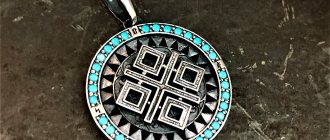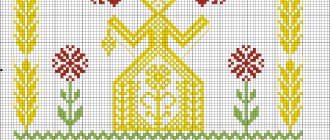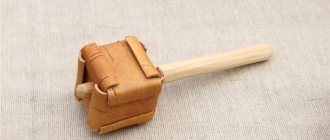Who is the goddess Makosh and who is her patron?
It is believed that Makosh, the Slavic goddess of fate, participated together with the main god Rod in the creation of the world. The legend says: the celestial goddess is busy creating the fabric of the world, weaving people and events into the fabric. Two assistants, happy Dolya and dashing Nedolya, help with this. By taking turns touching the threads on the canvas, the assistants determine fate, making a person’s life easy and lucky, or vice versa.
In Slavic mythology, it symbolizes the feminine principle of the universe, which is why Makosha was worshiped by women who considered her their intercessor. Bestows fertility, and this is a generalized concept, i.e. the goddess’s location promised both an easy birth and a good harvest in the field. The ancient Slavic goddess is a symbol of the family hearth, prosperity in the home, and family happiness.
She patronized wells, springs, places of special power - idols were placed there in her honor, yarn and balls of thread were left as gifts. According to legend, she plunged nature into hibernation and then awakened it in the spring. She played a special role in magic and fortune telling, because she could open her eyes to secret knowledge. The goddess's heritage is magic, fortune telling and women's activities, especially spinning.
Symbols of the goddess Mokosh.
Since ancient times, insects, more precisely bees, ants and spiders, were considered symbols and messengers of the goddess. In the case of bees, it is clear why they act as messengers of the goddess, since they are workers and are similar in their work to peasants who toil on the earth by the sweat of their brow. If a bee flew into the house, it could not be killed; it was believed that this would scare away good luck. The bees were caught and released into the wild, or they were first carefully wrapped in a scarf so that the bee would buzz a little in it and released afterwards, and the scarf was kept as a talisman for Mokosh. Spiders, like spinners, are also messengers of the goddess. Once a spider appeared in the house, it could not be killed, so as not to anger Makosh. The spider was considered a herald of the approach of the goddess herself or some very important event, which was necessarily connected with Mokosh. Ants were both workers and healers. Since ancient times, the Slavs believed that allowing ants to bite your hand could cure infertility. The spruce tree is also considered the symbol of Mokosh. The spruce is forever green, like the personification of life. It is worth remembering the fact that the temples of the god Veles were built at the intersection of three roads in the vicinity of fir trees. This is another reference to the relationship of these two gods, but the point is not at all that Makosh was the wife of Veles, as many mistakenly believe, but perhaps acted as his mother in the person of the cow that gave birth to him.
Mokosh's amulet symbolizes closeness to the essence of the universe. For the most part, this amulet was considered female, since women, in their strength, could both give life and take it, and their similarity with the creators of the world is much greater than that of men. But the Mokosh amulet could also be worn by men, especially those who held very important positions and made decisions, since the Mokosh amulet awakens intuition and allows you to understand the whole Essence. This amulet was depicted on many household items, but it was strictly forbidden to be applied to a warrior’s clothes or weapons, because despite everything, Makosh was the Mother who gives life. The amulet of the goddess Mokosh should be illuminated with water from a well, and in return, to appease the goddess, you need to leave a ball of thread, or best of all, something knitted with your own hands.
Origin, symbolism and meaning of the amulet
Two symbols were associated with the celestial goddess: the antisalt and the field. It was believed that the Slavic Goddess of Fate Makosh gave them to people so that they would always remember her patronage. For women, both signs were considered sacred and were often found on embroidery and jewelry. The embroidery that the mother herself made for her child had great power, protecting the baby from illnesses and accidents.











